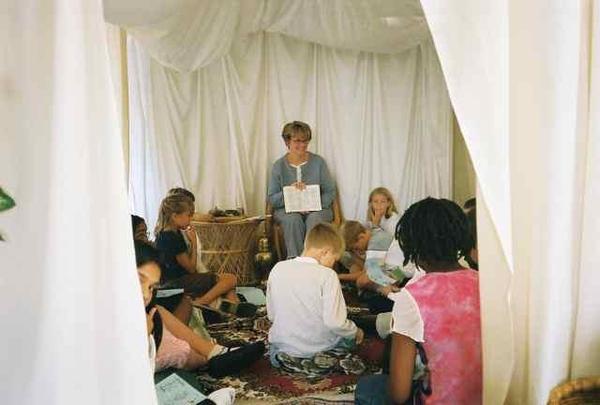More regarding tent set up...
From Myrna
We set up our tent by painting the walls "sand" color and then dry brushing a few different shades of "sand" on the walls to give it some depth. We then hung white muslin across the ceiling and down the corners of the wall. Wooden posts were painted in the corners and pottery painted along the floor. There is an oriental rug on the floor. Good luck!
From Nora
We painted our room to look like a desert, ocean, and mountain environment. We set up a free standing dining fly with a plastic cover. The legs were anchored to large pieces of wood and the dining fly was draped with striped material. The "tent" is 10ft by 10ft, we placed oriental rugs inside (pillows are coming soon), placed a few large urns by the entrance, and made a few trees for in the room. We just began using Rotation 2 weeks ago and we can't keep the kids out of the tent! They love to be inside as they hear stories, play quiet games, and do their journaling!
From Ed Lally
For our tent room, we had a volunteer pick up lots of CHEAP fabric at Wal-Mart and cut it into floor-to-ceiling lengths. In the top of each piece we have a small pocket.
Our walls are cinder block, so to mount the curtains we drilled holes and inserted masonry anchors with eye-hooks. We then ran steel 3/8" cable around the perimeter of the room and threaded the cable through the pockets in the fabric. We used screw-down cable binding clips to secure the cable ends. Once we tightened everything down, we had fabric covering all four walls.
We had an old fluorescent fixture in the ceiling which looked bad. To cover it up, we ran additional pieces of fabric across the short length of the room and pinned them down. They were pinned to the fabric hanging against the walls and were pinned to each other as they traversed the room. We then picked up two Torchère lamps that go on either side of the storyteller.
This all worked out pretty well with two caveats. First, the fabric can be pretty heavy, so you definitely want more than one person doing this. Also, the cables will stretch over time, so you'll periodically need to re-tighten them. (And the moderator notes: Be careful of covering electrical fixtures.)
Hope this helps!
Regards,
Ed Lally
St. Mary's Church
Haddon Heights, NJ
From crfowlkes
We went all out and created a tent that we could also use outdoors with added staking. The resource I used was http://www.creativeshelters.com. They have a utility called Design-a-Canopy that provides you with a framing supply list.
They sell the joints, you provide the framing tubing. They suggest EMT (electrical conduit). We covered it with muslin that we found on sale at Joann's for 50% off. I think we used about 15 yards of 90 inch fabric to make a tent that is 8 ft wide by 10 feet deep by 6 1/2 feet tall. Muslin can come with a flame retardant finish, check the label.
The sides are pieced together so that we can have all sides open or closed. We added to the desert atmosphere by putting 6 ft and 4 ft fake palm trees around the outside of the tent. The tent is in our Bible Stories and Skills Room. We call it Magic Carpet Ride and are hoping to add a "Persian" rug to the floor of the tent for more ambience. We use decorative wine tubes (for gifts) to hold our scripture scrolls, kind of like the Torah scrolls in a synagogue.
Share your tent stories and photos!





